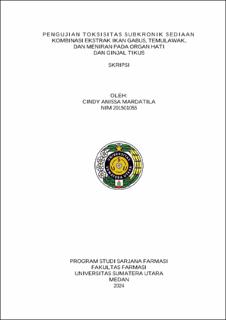| dc.description.abstract | Background: Snakehead fish has benefits as an anti-inflammatory, anticancer, and immunomodulatory enhancer. The benefits of temulawak include as an antioxidant, antihypertensive, nephroprotective, and hepatoprotective. Meniran is useful as a diuretic, expectorant, and appetite enhancer. Subchronic toxicity is a test to detect toxic effects that appear after administration of test preparations with repeated doses given orally to test animals for 90 days. The subchronic toxicity test will provide information on the toxic effect on the target organs.
Objective: To determine the potential of subchronic toxicity of a combined extracts preparation of snakehead fish, temulawak, and meniran (EIGTM) on liver and kidney organs of rats.
Methods: This study used an experimental method, using 70 male and female rats divided into 6 groups, namely the control group given CMC-Na 0.5% p.o; the test group was given EIGTM doses of 100, 300, 1000 mg/kgBB p.o for 90 days. The control satellite group was given CMC-Na 0.5% and the treatment satellite was given a dose of 1000 mg/kgBB p.o for 90 days and stopped for 28 days to observe the reversibility effect. Parameters observed were toxic symptoms, body weight, mortality, relative organ weight, macropathology, and histopathology of liver and kidney organs. Data were analyzed using Statistical Product and Service Solution (SPSS).
Results: Observation of toxic symptoms showed that rats were in good condition with no effect on physical behavior and no deaths. EIGTM dose of 1000 mg/kgBB affects the body weight and SGPT levels of male rats. EIGTM doses of 100, 300, and 1000 mg/kgBB affect the ureum levels of female rats. Based on the results of histopathology, EIGTM can cause changes in the liver and kidney organs of rats.
Conclusion: The administration of EIGTM for 90 days did not show toxic symptoms at doses of 100, 300, 1000 mg / kgBB, but affected on the liver and kidney organs of rats. The | en_US |


